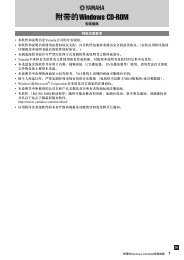Create successful ePaper yourself
Turn your PDF publications into a flip-book with our unique Google optimized e-Paper software.
Using the pedals<br />
The Clavinova has three foot pedals: damper pedal (right), sostenuto<br />
pedal (center), and soft pedal (left) that produce a range of expressive<br />
effects similar to those produced by the pedals on an acoustic piano.<br />
Damper (right) pedal<br />
When you press the damper pedal, the notes<br />
you play have a longer sustain.<br />
When you select Grand Piano 1, pressing the<br />
damper pedal activates the instrument’s special<br />
“Sustain Samples” to accurately recreate the<br />
unique resonance of an acoustic grand piano’s<br />
soundboard and strings.<br />
Sostenuto (center) pedal<br />
If you play a note or chord on the keyboard<br />
and press the sostenuto pedal while holding<br />
the note(s), the notes will sustain as long as<br />
the pedal is held. All subsequent notes will<br />
not sustain.<br />
Soft pedal (left)<br />
The soft pedal reduces the volume and slightly changes the timbre of notes<br />
played while the pedal is pressed. (The soft pedal will not affect notes that are<br />
already playing when it is pressed. Press the pedal immediately before you<br />
play the target notes.)<br />
With the Vibraphone and Jazz Organ voices, this pedal turns vibrato on and<br />
off or toggles the speed of vibrato. (See page 93.)<br />
�<br />
��<br />
When you press the damper<br />
pedal here, the notes you<br />
play before you release the<br />
pedal have a longer sustain.<br />
�<br />
��<br />
When you press the sostenuto<br />
pedal here while holding the<br />
note(s), the notes will sustain<br />
as long as you hold the pedal.<br />
��<br />
��<br />
��<br />
��<br />
Selecting and Playing Voices<br />
TIP<br />
If the damper pedal doesn’t<br />
work, or notes are sustained<br />
even when the pedal is not<br />
pressed, make sure that the<br />
pedal cord is properly<br />
plugged into the PEDAL jack<br />
on the unit (see step 5 on<br />
page 113 (<strong>CLP</strong>-<strong>150</strong>), see<br />
step 6 on page 116 (<strong>CLP</strong>-<br />
<strong>170</strong>)). Also, make sure that<br />
the RPedal parameter in the<br />
“VOICE SETTING” menu is<br />
set to ON (see page 83).<br />
TIP<br />
You can adjust the depth of<br />
the resonance produced by<br />
the “Sustain Samples” using<br />
the Sustain Sampling Depth<br />
parameter in the “OTHER<br />
SETTING” menu. (See<br />
page 93.)<br />
TIP<br />
You can assign a function to<br />
each pedal via the “R<br />
Pedal”, “M Pedal”, and “L<br />
Pedal” parameters in the<br />
“VOICE SETTING” menu.<br />
(See pages 83, 84.)<br />
TIP<br />
The center and left pedals<br />
can also be assigned to<br />
song start/stop operation<br />
(START/STOP function) via<br />
the “PedalStart/Stop”<br />
parameter in the “OTHER<br />
SETTING” menu (on<br />
page 94).<br />
<strong>CLP</strong>-<strong>170</strong>/<strong>150</strong> 29


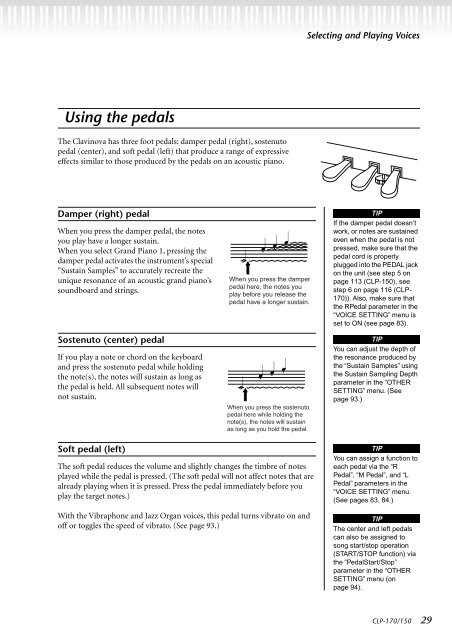

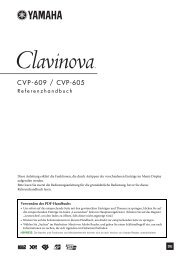

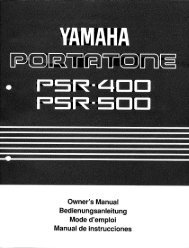

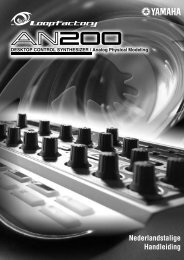
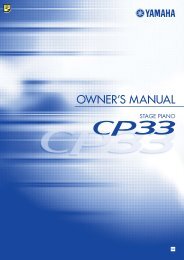


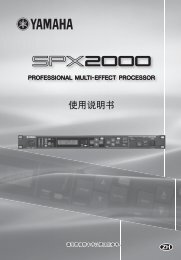
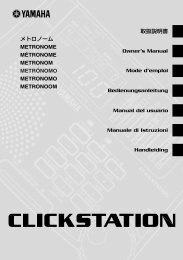
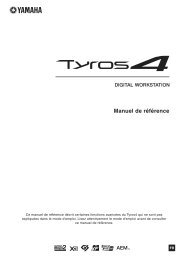
![Premere il pulsante [SONG] - Yamaha](https://img.yumpu.com/50419553/1/184x260/premere-il-pulsante-song-yamaha.jpg?quality=85)
